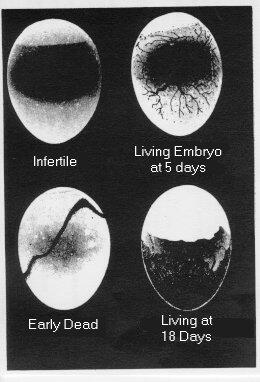Poultry
Testing incubated eggs for embryo development

Make a tester or candler by placing a light bulb and fixture inside a cardboard box. Cut a small, round hole in the top or side of the box, and let a narrow beam of light escape from the box. You can see the internal features of the egg by placing it against the hole. A darkened room makes testing easier.
The eggs are normally tested after 4 to 7 days of incubation. Eggs with white shells are easier to test and can be tested earlier than dark shelled eggs. Two classes of eggs can be removed on the basis of this early test, "infertiles" and "dead germs." "Infertile" refers to an unfertilized egg or an egg that started developing but died before growth could be detected. "Dead germs" refers to embryos that died after growing large enough to be seen when candled.
An "infertile" appears as a clear egg except for a slight shadow cast by the yolk. A live embryo is spider-like in appearance, with the embryo representing a spider's body and the large blood vessels spreading out much like a spider's legs. A "dead germ" can be distinguished by the presence of a blood ring around the embryo. This is caused by the movement of blood away from the embryo after death.
If you are not sure whether the embryo is alive, place the egg back in the incubator and retest later. A second test can be made after 14 to 16 days of incubation. If the embryo is living, only one or two small light spaces filled with blood vessels can be seen, and the chick may be observed moving.
Poultry
- Best Breeds of Chickens
- Breeds and varieties of chickens
- Causes for hens eating their eggs
- Causes of pecking and cannibalism
- Causes of Poor Feathering
- Chick removal from hatchery
- Commercial Poultry
- Constructing a Plywood Incubator
- Constructing a Polystyrene Incubator
- Construction of a still-air incubator
- Contents of chicken egg
- Culling Hens
- Disease and Pest Control
- Diseases of Poultry
- FAQ
- Feeds and Nutrition
- Fumigation and sanitation of hatching eggs
- Game Birds and Ratites
- General characteristics of Disinfectants
- Good management of egg producing hens
- Hatchery Management Guide for Game Bird and Small Poultry Flock Owners
- Hatching egg storage period
- How long to produce fertile eggs?
- Important incubation factors
- Incubation duration periods
- Incubation temperature requirements
- Management of egg producing hens
- Mistakes When Grilling Broilers
- Molting of laying hens
- Pesticides
- Pesticides Used for Control of Poultry Insect Pests
- Pipped eggs that do not hatch
- Quail Brooding Temperatures
- Quail Feed Formulations
- Quail Feed Medications
- Quail Feeding Programs
- Quail Pox
- Raising Backyard Chickens - Bio Security
- Reproduction & Incubation
- Sanitation of hatching eggs
- Sexing of day-old chicks
- Small Flock Management
- Solutions and Treatments
- Space needs of Bobwhite Quail
- Stages in chick embryo development
- Stimulating the setting instinct
- Temperatures recommended for brooding quail
- Testing incubated eggs for embryo development
- Time hens continue to produce fertile eggs
- Treatments for External Poultry Parasites
- Treatments for Poultry Parasites
- Trouble Shooting Failures with Egg Incubation
- Ulcerative Enteritis in Quail
- Washing of hatching eggs
- Why do hens stop laying eggs?
- Will all hens set on eggs?